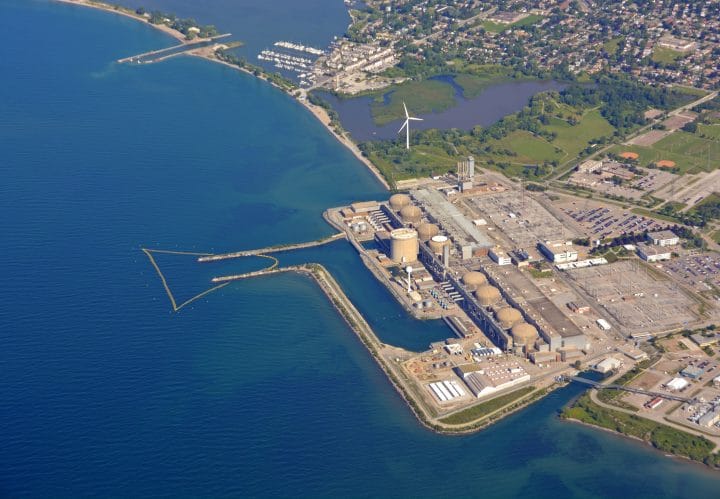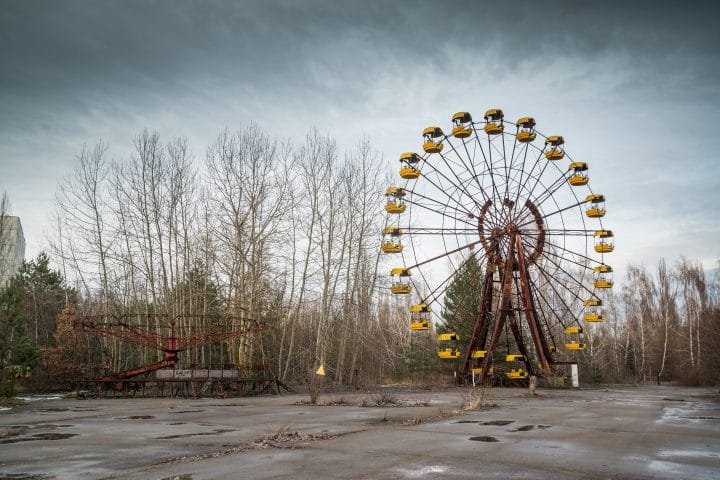This article explains the different pros and cons of nuclear energy. Learn more about the aspects that make it good and those that make it bad.
Nuclear Energy Pros
Let’s start by taking a look at the different benefits that nuclear energy provides. These wide-ranging positive factors are the key reason why nuclear power is so prevalent in today’s world.
1. Zero Emissions
Most nuclear reactors work by using a reaction known as nuclear fission. Here, neutrons are fired at atoms, splitting them into smaller versions of themselves. This process releases large amounts of energy without the need to burn any fossil fuels.
The fact that nuclear energy doesn’t burn fossil fuels means it has no greenhouse gas emissions. Nuclear reactors produce zero carbon dioxide or methane. By using nuclear power, we can lower our reliance on fossil fuel alternatives such as coal, oil, and gas. This helps to improve air quality and curb the effects of global warming.
2. High Energy Density
Most nuclear reactors use uranium as their fuel source. Uranium has a significantly larger energy density than coal, oil, and gas.
According to the Nuclear Energy Institute, a single uranium fuel pellet the size of your fingertip has as much energy as:
- 1 ton of coal
- 149 gallons of oil
- 17,000 cubic feet of natural gas
From these figures, it is clear to see how dense nuclear fuel actually is. This has numerous benefits including the ability to generate more power and better conserve natural resources.
3. Efficient & Reliable
We mentioned earlier how nuclear fission involves firing neutrons at atoms in order to split them. Well, during this reaction, other netrons are also released. This can set off a chain reaction, meaning nuclear fission can be sustained for long periods of time.
The fact that nuclear fission can be sustained makes it very reliable. Most nuclear reactors can run non-stop for 1 or 2 years before needing to be refueled.
4. Low Operating Costs
Although the construction of nuclear power plants is very expensive, operational costs can be lower than coal, oil, and gas alternatives. Nuclear reactors can run for long periods of time using a lower amount of fuel than traditional power plants.
5. Minimal Waste
Whilst waste can be a disadvantage of nuclear energy, it actually produces less than you might think. This is because nuclear fuel is extremely dense. According to the United States’ Office of Nuclear Energy, nuclear fuel is around 1 million times denser than that of traditional energy sources.
The Nuclear Energy Institute estimates that all of the used fuel produced by commercial nuclear power plants since the late 1950s would cover a football field to a depth of around 10 yards. They have a great article on nuclear waste here.
Compare this to coal power plants that produce the same quantity of waste every hour and you can see how minimal nuclear waste actually is. That being said, nuclear waste is far more hazardous than waste from fossil fuel power plants.
6. Small Land Footprint
Nuclear power plants have a much smaller land footprint than other clean energy technologies such as solar and wind.
Smaller plants of around 1000 MW can take up as little as one square mile for the reactor and its associated structures. Compared to some solar farms of a similar capacity, this is around one-third of the footprint.

7. Future Potential
Nuclear power offers what is arguably the most promising future over all other sources of energy put together. Today’s commercial nuclear reactors use nuclear fission to generate electricity. There is however a more radical approach known as nuclear fusion which might one day revolutionize how we generate our power.
Instead of splitting atoms as nuclear fission does, nuclear fusion joins (or ‘fuses’) two atoms together. This reaction is similar to the one that fuels the sun and therefore offers a huge amount of potential. Scientists consider it the holy grail of energy production but have so far been unable to sustain nuclear fusion for long enough periods of time to make it efficient.
It is hoped that nuclear fusion reactors will one day be able to replace nuclear fission. This will allow almost limitless energy production without the long-lived radioactive waste associated with nuclear fission.
Nuclear Energy Cons
So what about the drawbacks of nuclear energy? There are indeed numerous downsides associated with it. Let’s take a look at these negative factors below.
1. Radioactive Waste
Nuclear fuel such as uranium has a lifespan of around five years. After this point, it has to be removed from the reactor and moved to a storage pool for several years until it has cooled.
The much-disputed question is what do we do with this spent fuel in the long term? It is classed as high-level radioactive waste and can remain harmful for thousands of years. Most countries choose to export this waste for others to deal with or store it themselves in high-security facilities but this still doesn’t get rid of the problem.
Fortunately, as we mentioned earlier, there isn’t as much nuclear waste as you might think. Some countries have even developed ways to reprocess spent nuclear fuel. In addition to this, some modern advanced reactor designs currently under research are capable of running on spent fuel. This offers a possible new solution for what to do with radioactive waste.
2. Nuclear Accidents
One of the main disadvantages of nuclear power is the potential for accidents. You will no doubt have heard of high profile incidents such as Ukraine’s Chernobyl disaster in 1986 and Japan’s Fukushima Daiichi disaster in 2011.
Both the Chernobyl and Fukushima disasters released large amounts of radioactive particles into the atmosphere. These particles then fell and contaminated land many miles away from their source. As a result, exclusion zones of up to 19 miles have been established in both locations.

Nuclear radiation doesn’t just kill people in the short term. It can last tens, hundreds, or even thousands of years depending on the severity. It can seep into vegetation, water, and soil, causing widespread issues. Cancer, birth defects, and other long term illnesses can be attributed to radiation released by nuclear incidents.
3. Limited Resources
The fuel used in nuclear reactors (such as uranium and plutonium) is non-renewable and is, therefore, a finite resource. This fuel will one day run out, just like coal, oil, and natural gas.
4. Expensive To Build
To build a nuclear power plant takes a long amount of time, research, and investment. According to this report by the U.S. Energy Information Administration (EIA), this is how nuclear energy compares to some other alternatives:
| Plant Type | Capital Cost ($/kW) |
|---|---|
| Concentrating Solar Power Plant | 7,221 |
| Hydrogen Fuel Cell Plant | 6,700 |
| Small Modular Nuclear Reactor | 6,191 |
| Advanced Nuclear Reactor | 6,041 |
| Coal Power Plant (With 90% Carbon Capture) | 5,876 |
| Hydroelectric Power Plant | 5,316 |
| Coal Power Plant (With 30% Carbon Capture) | 4,558 |
| Offshore Wind Farm | 4,375 |
| Biomass Power Plant | 4,097 |
| Coal Power Plant (No Carbon Capture) | 3,676 |
| Geothermal Power Plant | 2,521 |
| Solar PV Farm* | 1,534 |
| Onshore Wind Farm* | 1,471 |
* Where appropriate, figures have been averaged based on similar plant types.
As you can see from this data, nuclear reactors have one of the highest capital costs per kW of the power plants shown. They are only beaten by concentrated solar power (CSP) and hydrogen fuel cell plants.
5. Nuclear Weapons
And now we come to the elephant in the room – nuclear weapons. We should remember that the nuclear arms race is the main reason why nuclear power exists today.
In the years up to and during World War II, scientists raced to invent a working nuclear bomb. On August 6th, 1945, the United States dropped the first nuclear bomb used in anger on the Japanese city of Hiroshima. The initial impact decimated the city, killing an estimated 80,000 people. Several days later, the US dropped another bomb on Nagasaki, effectively ending the war.
Since World War II, no country has used nuclear weapons in anger. Instead, several countries have stockpiled such weaponry to act as a deterrent against current or future enemies.
Some might say that nuclear weapons have helped to maintain peace and avoid another all-out war. However you look at this, nuclear weapons have still been responsible for wiping out large populations. They have also been attributed to various long term health conditions and birth defects.
Overview
So there we have the advantages and disadvantages of nuclear energy. On the one hand, nuclear power is the answer to providing vast quantities of clean electricity for the masses. On the other, it can be hazardous to our health and does consume natural resources.
Whichever way you look at it, nuclear energy has a number of pros and cons and is here to stay. Nuclear is the go-to choice for many countries all over the world looking to provide a source of efficient and reliable energy for their country. Whatsmore, with no greenhouse gases, it is one of the cleanest power sources available today.